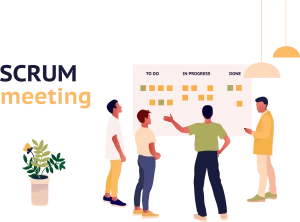In today's dynamic work environment, Agile methodologies have become increasingly prevalent, emphasizing collaboration, adaptability, and iterative progress. However, with the rise of remote or distributed teams, it's crucial to tailor Agile practices to ensure effective communication and coordination. Here's how Agile meetings can adapt to remote or distributed teams:
Leveraging Technology for Seamless Communication
Utilizing Video Conferencing Tools
Agile meetings, such as stand-ups, sprint planning, review, and retrospective, can be conducted via video conferencing platforms like Zoom, Microsoft Teams, or Google Meet. These tools offer features like screen sharing and virtual whiteboards to facilitate real-time collaboration.
Employing Chat and Messaging Apps
Integrating chat and messaging apps like Slack or Microsoft Teams enables team members to communicate asynchronously, share updates, and ask questions without scheduling formal meetings. This fosters continuous communication and quick decision-making.
Adapting Agile Ceremonies for Remote Collaboration
Agile Stand-up Meetings
In remote settings, daily stand-up meetings can be conducted using video conferencing tools. Each team member shares their progress, challenges, and plans for the day. To maintain engagement, team members can rotate the facilitation role, ensuring everyone contributes.
Virtual Sprint Planning Sessions
For sprint planning, teams can utilize collaborative online boards like Trello or Jira. Prior to the meeting, user stories and tasks are outlined, allowing team members to review asynchronously. During the session, the team collectively estimates and prioritizes tasks, ensuring alignment and commitment to sprint goals.
Remote Sprint Reviews and Retrospectives
During sprint reviews, the team demonstrates completed work via screen sharing and receives feedback from stakeholders. Retrospectives can be conducted using online survey tools like Google Forms or dedicated retrospective apps. Team members reflect on what went well, areas for improvement, and action items for the next sprint.

Ensuring Collaboration and Accountability
Establishing Clear Communication Channels
Define communication protocols, such as designated chat channels for specific topics and regular update schedules. This ensures transparency and keeps everyone informed about project progress and blockers.
Implementing Agile Project Management Tools
Utilize Agile project management tools like Jira, Asana, or Monday.com to track tasks, user stories, and progress in real-time. These tools provide visibility into the project's status, allowing teams to adapt quickly to changing requirements or issues.
Encouraging Cross-functional Collaboration
Promote cross-functional collaboration by scheduling virtual coffee breaks or informal team bonding activities. This fosters rapport among team members and strengthens collaboration, despite physical distance.
In conclusion, while remote or distributed teams present unique challenges, Agile methodologies can be adapted effectively through leveraging technology, adapting ceremonies, and fostering collaboration. By implementing these strategies, teams can maintain productivity, cohesion, and efficiency in achieving project goals.
